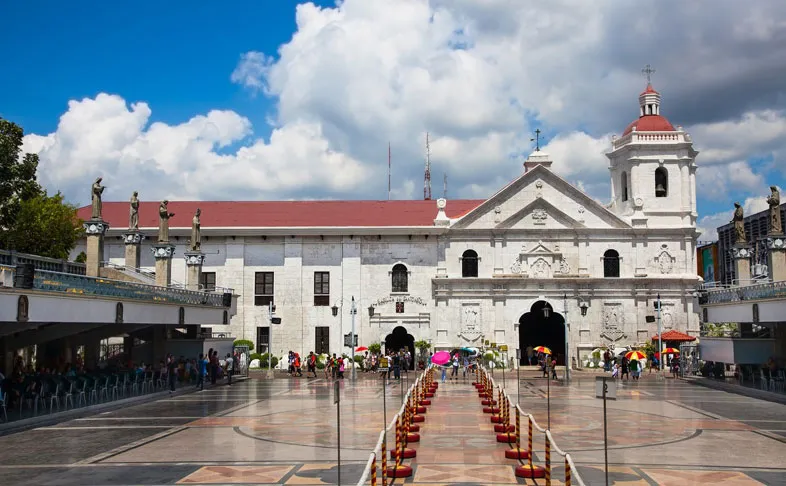
Introduction
Basilica Minore Del Santo Niño is known as the oldest Catholic Church in Cebu. The church houses the image of the Santo Niño, the city’s patron saint that represents Jesus as a black Holy Child. It is also a place for prayer and pilgrimage to a large number of people each year.
In 1565, Miguel Lopez de Legazpi called Basilica Minore Del Santo. Niño as San Agustin Church. The exact location of the church is the same spot where Legazpi’s Spaniard troupe discovered the image of Santo. Niño. It was thought to be the gift of Ferdinand Magellan to Queen Juana, the wife of Rajah Humabon, as a sign of their allegiance and over forty years after their baptism to Christianity.
The statue was found in a burnt wooden box left behind during the time of Magellan. Having been able to survive the fire, the Spaniards thought it to be a miracle that the image did not turn into ashes. On April 28, 1565, the same day Legazpi and his crew landed on Cebu, Augustinian priest Fr. Andres de Urdaneta founded the Santo Niño monastery. The first church was then built in 1566 by Fr. Diego de Herrera with only wood and nipa. Unfortunately, the church was consumed in fire. That time, the image of Santo Niño survived again.
The new wooden church was built in 1605 by Fr. Pedro Torres, but another fire destroyed the church again in 1628. The third church was built that same year by Fr. Juan Medina, this time using stones and bricks. But the construction did not continue due to the lack of materials used.
On February 29, 1735, the new construction of the church was led by a number of people, Father Provincial Bergano, Governor-General Fernando Valdes, Bishop Manuel Antonio Decio y O campo of Ceby, and Juan de Albarran. Utilizing hewn stones, the present church was finished in 1739. By 1965, Pope Paul VI converted the church into Basilica Minore.
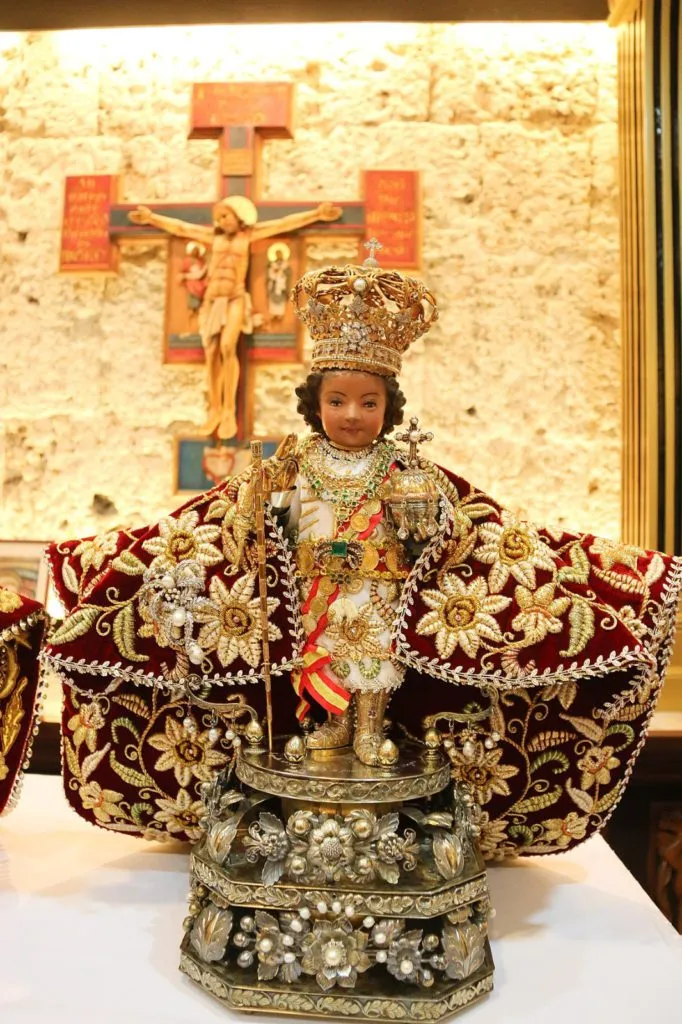
The statue is from early 16th century made out of wood, with an approximate height of 90cm. When Miguel Lopez de Legazpi and his troops landed in the island of Sugbu (former name of Cebu) on 28 Apr 1565, they burned down the whole settlement they found there to drive all residents out of the land. The statue of the Santo Niño was discovered among the ruins by Juan de Camus, one of Legazpi’s sailors. The icon was wrapped in white cloth and kept inside a Spanish crafted wooden box.
The image’s survival from destruction by fire and its discovery were considered miracles, and Legazpi decreed the propagation of the devotion to the Holy Child. This is the first of the multitude of devotions to the Holy Child in various localities in the Philippines (Bautista 2001, 15-16). The image was then entrusted to the Augustinian Missionaries and six years after, a church was built on the site where it was found. This church was named after the Holy Name of Jesus and is considered to be the first Christian church ever built on the Philippines.
The primary historical significance of the image of the Santo Niño de Cebu lies in the theory that it was among the images that Ferdinand Magellan brought with him from Spain in 1521. The image of the Holy Child that Magellan brought is said to be a product of the Spanish colony of Flanders in Belgium. Carved in wood, it was dressed up in the traditional costume for children of the Spanish court of the late 16th and the 17th centuries. It had a long-sleeved shirt with lace ruffles and gold-embroidered vest over a pair of trousers tucked into a pair of gold boots worn up through the middle lower legs. The image also wears a princely ensemble comprised of a crown, a sash, a belt, and a long flowing cape.
The Holy Child’s right hand is raised in benediction, as it holds a sceptre symbolizing martial law and power to impose justice. Its left hand holds an orb with a cross, symbolizing the dominion of the child Jesus over all creation and the sovereignty of Spain over a vast territory around the globe (Bautista 2001, 13). The vestment of the Santo Niño de Cebu is predominantly red. The image stands on a tall ornamented pedestal.
Noteworthy adornments of the image include a chain of old Spanish gold coins, the toisonne allegedly bequeathed by King Charles III, and a golden ram pendant. The image was originally ebony in colour but was repainted in pale yellow after World War II to conceal a scratch on the image’s right cheek (Florendo 2001, 21).
According to the account of Magellan’s chronicler, Antonio de Pigafetta, a beautiful image of the Holy Child with other images was presented to Hara Amihan, the wife of Rajah Humabon of Cebu as she was baptized with the Christian name Juana. Juana was brought to tears as she beheld the image and thus asked that the image be left with her (Bautista 2001, 14-15).
This account extended to tales of Juana leaping and dancing the sulog (the dance of the tides) along with her handmaidens as she took possession of the Santo Niño. Her reaction marked the warm reception and adoration the Filipinos have since accorded the Santo Niño. Juana’s jubilant acceptance of the image of the Holy Child has since been regarded as having given birth to the Sinulog dance and eventually the Sinulog festival, a celebration that honors the feast of the Holy Child of Cebu annually every second Sunday following the feast of the Epiphany. The Sinulog dance and festivities are punctuated with shouts of “Viva! Pit Senyor!” as the Holy Child is referred to by devotees as “Senyor Santo Niño”.
The Santo Niño image is replicated in many homes and business establishments, with different titles reinterpreted in various areas of the country. The image is one of the most beloved and recognizable cultural icons in the Philippines, found in both religious and secular areas. It is permanently encased within bulletproof glass in a chapel at the Basílica Menor del Santo Niño.
The Minor Basilica of Santo Niño was built on the spot where the image was found by Juan Camus. The church was originally made out of bamboo and mangrove palm and claims to be the oldest parish in the Philippines. Pope Paul VI elevated it to the status of Minor Basilica on its 400th anniversary.
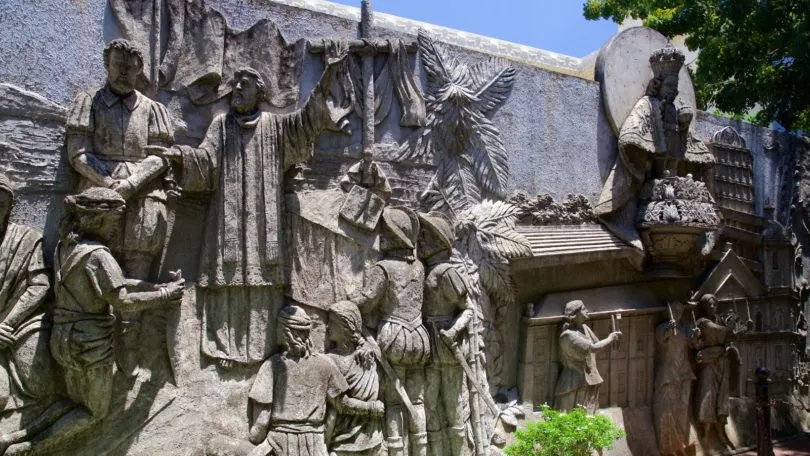
The Santo Niño church traces all the way back to the earliest long stretches of the Augsutinians in the Philippines. The nipa house where the Santo Niño was found, as well as the encompassing region, was doled out to the Augustinians where they fabricated the first church in quite a while. In this little and transitory structure the Santo Niño was housed. After six years Fr. Martin de Rada started the development of chapel and religious community. These structures were made of light material in consonance with the style around then in the islands. Destroyed by fire, the Augustinians chose to fabricate them of more grounded materials.
Work began in 1575 or 1576, and completed in 1602, because of Dn. Gabriel Gonzalez and his better half Doña Catalina Sanchez, extraordinary enthusiasts of the Santo Niño, who bore the costs, even the part previously developed. The religious community in 1599, composed that the cloister was bery poor and barely had four wooden rooms. To finish crafted by both cloister and church, Lead representative General Pedro Bravo de Acuña, requested the city chairman of Cebu to pay quickly the allowance because of the Santo Niño church, and to give the important work.
Without withstanding the solid material, on Walk 8, 1628, a major fire bulldozed to the ground the two structures, as well as a piece of the town. Fr. Juan de Medina, earlier at that point and an onlooker of the lamentable occasion, lets us know that “at one o’clock the fire started in the city… the breeze was lively, and blowing toward the cloister. To put it plainly, everything was scorched, however we saved the silver and whatever conceivable… This occurred on Saturday, the night before Enthusiasm Sunday. I accumulated all that ran away to the religious community of San Nicolas, and set about going to Manila, to fix that misfortune quite far.”
Fr. Medina went to Manila to ask authorization and request assets for the new structures. While in Manila, he addressed a request to the Lord for the genuinely necessary assistance. With the support and help from the Augustinians in the Islands, he began the new structures. These subsequent church and cloister remained more than 100 years.
In 1729, part of the material and façade of the congregation tumble down. Fr. Jose Bosqued, taking into account the structure in vile condition chose to flatten it and supplant it with more grounded one. Consent acquired from the Top of the Augustinians in Manila, Fr. Bosqued lacking assets and difficult work, engaged Fenando de Valdes y Tamon, Govenor General of the Islands, to permit a few locals of the towns of San Nicolas, Carcar and Boljoon to work in the new church, and free them from anything polo or administration they were bound to.
With finances close by and the guaranteed assist by the Lead representative With generaling, Fr. Bosqued started, in 1730, the development of a block church, as he suspected it impractical to track down stone in Cebu Islands for the venture. Due to the sticky atmospheric condition in the island, the blocks before long began to crumble. In this manner, after three years, his replacement, Fr. Jose Treviño, requested the suspension of the work, when development had scarcely come up to window level.
Nonetheless, he kept social event materials from adjoining islands for the development of a superior, greater and more strong church. Around then in Bauan, Ilocos there carried on with an in Augustinian building temples in the Philippines. He was Fr. Juan Albarran, who crushed whatever Fr. Bosqued constructed. He confronted similar hardships as his ancestors: absence of proper materials. Informed that the main stones accessible in the island had proactively been utilized for the development of the Colegio of the Jesuits, Fr. Albarran, proceeded with his quest for stone for an entire year.
Some great stone found in the town of Carcar he utilized for the groundworks of the congregation. Afterward, he found a major quarry in Mactan Island which could supply any amount required for the undertaking. As Mactan was isolated from Cebu Island, presently Fr. Albarran needed to tackle another issue, the transportation of the materials to the site of development. Around then, as per reports, there were no bancas in Ceu. The main arrangement was to get the bancas from Capiz and Skillet ay until they could be inherent Cebu from the hard wood Fr. Albarran himself looked for in the mountains of Talisay and Pitalo.
On February 24, 1735, Fr. Albarran, with the assistance of Fr. Antonio Lopez, OSA, Earlier of San Nicolas, began the underpinning of the congregation. Physical work was given from San Nicolas, Talisay and for some time, from Mactan Island. After five years, on January 16, 1740, the current church was honoured and the statuette of the Santo Niño was put in its own special raised area. The event was featured with a multi-day festivity with strict and municipal exercises. Cebuano’s and individuals from the entire Visayas travelled to the Santo Niño place of worship to give recognition to their defender and supporter. The cloister was begun in 1751 and was done around the year 1773.
Work on the congregation went on in the succeeding years. Fr. Pedro Espineyra, replacement of Fr. Albarran, completed the roof, made a wooden ensemble (supplanted by the current Fr. Manuel Ibeas), and plated the retables.
In 1773, the entire inside of the congregation was painted. Dn. Protasio Cabezas, Cleric of Cebu, gave in 1755 the primary organ, offered to the theological school in 1875 by Fr. Gabriel Alvarez. This was supplanted in 1965, during the Fourth Centennial of the Proselytizing of the Philippines. The lectern was requested by Fr. Mateo Diez in the last part of the 1880s and the side special stepped areas by Fr. Fernando Magaz in 1886. The first wooden-shell windows were supplanted by the current ones of iron by Mateo Diez. The ceiling fixtures were purchased by Fr. Valerio Rodrigo toward the start of this long period.
All through the years the congregation went through a few minor fixes. In any case, in 1964 as groundwork for the solemnities during the Fourth Centennial Proselytizing of the Islands, Fr. Restituto Suarez and later the late Fr. Casimiro Garcia, made a significant cosmetic touch ups in chapel and cloister (Policarpio Hernandez, OSA).
Architecture of the Church
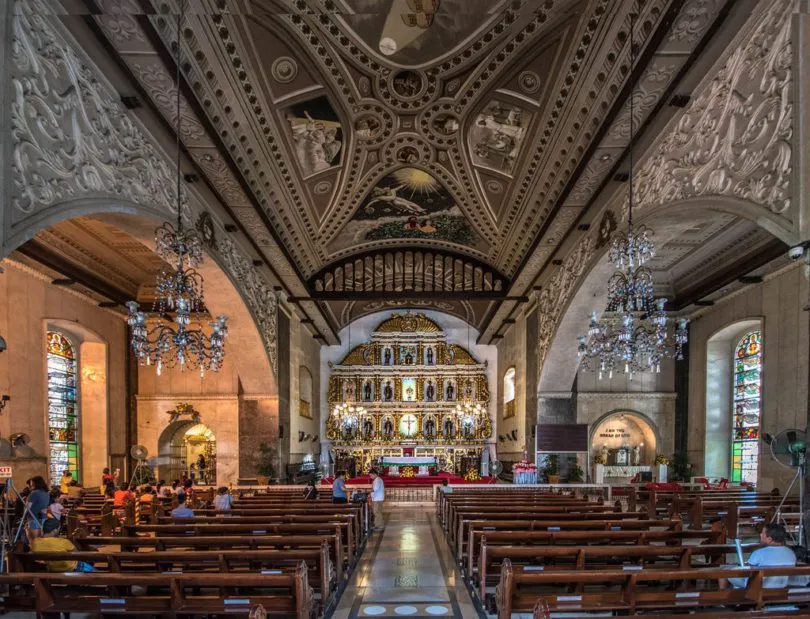
Facade is a blend of Muslim, Romanesque and neo-classical features that all set in what has otherwise been described as a high degree of integration. The façade is preserved in its original stone texture and natural colour, conveying an air of simplicity of line and elegance.
Bell tower serves as a counterbalance to the convent located on the opposite far end. It has two blind and open windows alternating in shape, ending up in triangular pinnacles with a circular disc crowned by balusters and a bulbous dome of Muslim influence.
Centre section is the focus of attention. The arched main entrance is balanced by the side rectangular corners. A double-edged triangular pediment crowns the facade.
Convent
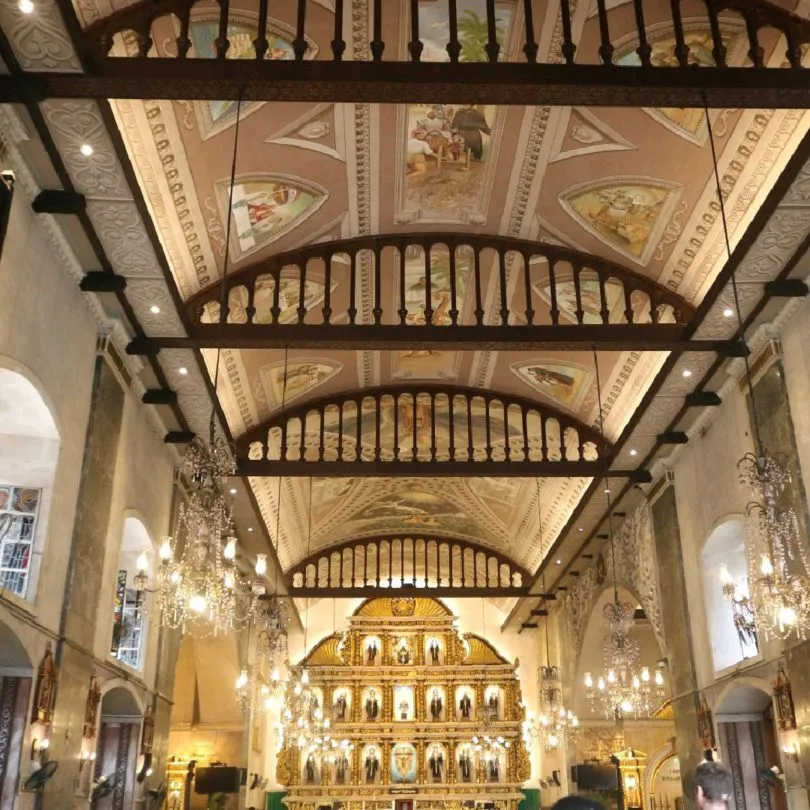
Upon their arrival in Cebu in April 1565, the troops of Miguel Lopez de Legazpi stumbled upon a remarkable discovery amidst the chaos – an image of the Christ Child hidden within a burning house. Amidst the smouldering remnants, a Basque soldier named Juan Camus uncovered the image, still safely encased in a wooden box. This image, clearly depicting the Santo Niño and crafted in the style of Flanders, was seen as an auspicious sign by the Augustinians accompanying Legazpi’s expedition. It was on 28 April 1565 that the Augustinians established their first house in Cebu, believing that this discovery foreshadowed favourable outcomes.
With plans for the urbanization of Cebu set in motion on 8 May, a designated site was allocated for the construction of a church and convent dedicated to Saint Augustine. In haste, a chapel made of wood and nipa was erected, and the image of the Santo Niño was reverently enthroned within it. On 1 June of the same year, Fr. Diego de Herrera, an Augustinian friar, was appointed as the first prior of the newly established convent, solidifying its place in Cebu’s spiritual landscape.
In 1599, the role of the convent expanded as it became a house of studies, led by the Visayan linguist Fr. Alonso de Mentrida. This institution provided education in grammar and also served as a haven for missionaries working in the province, offering them respite and shelter. Additionally, it acted as a place of retirement for the elderly and infirm, typically cared for by a dedicated lay brother. Over time, the convent’s multifaceted purpose made it an integral part of Cebu’s history and spiritual development.
The adjacent convent, built around an atrium, still serves as the residence for Augustinian priests. The first story houses parish offices, while the second story contains the friars’ living quarters. A beautifully carved stairway, adorned with Chinese-style lion motifs on the newel post, leads to the spacious aula or living room, featuring a 19th-century painting of Augustinian saints, with a copy found in the San Agustin Museum in Manila. Access to the second story requires permission.
In 2016, a stunning stained glass artwork depicting the Holy Family, including the Santo Niño, the Blessed Mother resembling Our Lady of Consolation, and Joseph, was installed on the stairway leading to the convent’s second floor.
The Santo Niño of Cebu museum, once located on the first story, has been relocated to bleachers constructed in front of the church. This move accommodates visitors during the Sinulog festivities and overflow crowds on church holy days.
Patronage
The Santo Niño was popularly considered the official patron of Cebu, but the Church in the Philippines suppressed the notion and clarified that it is not the representation of a saint that intercedes to God but rather God in the person of Jesus. Instead, the Archbishop of Cebu, Cardinal Ricardo Vidal, declared Our Lady of Guadalupe of Cebú as the principal patroness of Cebu on 2002.
The devotion to the Santo Niño is common with worldwide veneration of the Infant Jesus of Prague. The image is found in many houses, business establishments, and public transportation. Traditionally, the image is often dressed in one of two colours: red is common for domestic images, while green symbolising luck is worn by those enshrined in businesses. It is also often dressed in miniature costumes that often reflect the profession of its devotee such as physicians, nurses, policemen, or teachers. Another popular variation is the Santo Niño de Atocha which in the country is uniquely in a standing pose rather than seated as with the Spanish version.
Library
Inspired by St. Augustine’s wisdom that every house should have a library, the Augustinian Friars of the Basilica established their own library within the convent. While its exact founding date remains uncertain, it likely coincided with the construction and completion of the convent in 1764. The library once featured beautifully adorned ceilings, though tragically, a fire in the mid-1980s destroyed these artistic treasures.
This library boasts a mezzanine level where a wealth of old books is carefully stored. On the mezzanine walls, you’ll find a gallery honouring the past Rectors of the Basilica from 1951 to the present. Additionally, the library houses a substantial coat-of-arms of the House of Hapsburgs, an antique image featuring the Child Jesus, St. Joseph, and the Blessed Virgin Mary.
Historically reserved exclusively for the Friars, the library opened its doors to researchers in the year 2000, offering its resources to aid in various studies. Since then, it has welcomed numerous researchers investigating subjects such as the Santo Niño de Cebu, the Basilica, the convent, and the Augustinians in the Philippines and around the world. The library’s collection extends beyond these topics, encompassing a wide range of disciplines, including history, religion, theology, philosophy, social sciences, languages, arts, and literature. In addition to its antique volumes, the library houses special collections featuring rare photographs commemorating the Fourth Centennial of the Philippine Christianization in 1965.
The library’s logogram features a distinctive coat-of-arms: an eagle with two heads and outspread wings, symbolizing the union of two powerful entities, the Austrian and Spanish Hapsburgs, connected through royal intermarriage. The eagle signifies noble stature, strength, bravery, and protection.
Museum
The museum’s origins trace back to 1965 when it was established by Rev. Fr. Ambrosio J. Galindez, O.S.A., with a primary focus on commemorating the fourth Centennial Celebration of the Christianization of the Philippines. Initially, it was situated within the Basilica Minore del Santo Niño de Cebu Convent, where it housed vestments and an array of offerings dedicated to Santo Niño.
In 1995, recognizing the growing number of visitors and devotees, as well as the expanding collection, the Augustinian community relocated the museum to the basement of the Santo Niño Pilgrim Centre. This move provided a more spacious and suitable setting for the museum’s exhibits.
The museum’s core mission remains unchanged: to educate people about the historical origins, circumstances, and events surrounding the formal Christianization of the Philippines through the veneration of Señor Santo Niño de Cebu.
Dagkotanan
For those who are seeking a more intimate space for their private prayers, a designated candle area known as “DAGKOTAN” is available on the right side of the Pilgrim Center, facing the altar. From there, you may select a red candle conveniently placed within boxes. The process is of three steps Choose a red candle, ignite it, and engage with your heartfelt prayers.
The present location of the Candle Area or Dagkotanan was only constructed in 2005. Before, it was located inside the Basilica Church at the inner garden. Due to a fire in the previous year caused by lighting long candles, the Augustinian friars decided to move it to the basketball court in between the Pilgrim Centre and the Colegio del Santo Niño building.
The Gazebo of Magellan’s Cross in Cebu serves as a significant religious and pilgrim site, commemorating the establishment of Christian faith in the region. Its historical roots trace back to the arrival of Ferdinand Magellan in 1521 when, according to Antonio Pigafetta’s accounts, a cross was erected as a symbol of the intention to spread the Christian faith. The baptism of Rajah Humabon and his followers was a pivotal event during which a large cross was set up in the central square.
The fate of the original Magellan’s cross remains debated among historians, with some suggesting it was never successfully removed by the Cebuanos. However, it is believed that another cross was erected at the same spot in 1521 by the Augustinians of the Legazpi expedition in 1565. This cross miraculously survived a fire and was venerated as the “Cross of the Spaniards” or “Santa Cruz.”
Magellan's Cross
The Magellan’s Cross Gazebo is not merely a cultural landmark but a religious site, embodying devotion and faith. It has inspired Christian action and served as a center of devotion alongside the Santo Niño Church. Over the years, the cross has been a focus of religious veneration, with devotees sometimes taking wood fragments as religious mementos.
In 1834, Bishop Santos Gomez Marañon ordered the construction of the current octagonal gazebo, made of coral stone and covered with a red-tiled roof. The interior features a ceiling painting depicting the baptism of Rajah Humabon and the planting of the cross by Ferdinand Magellan, attributed to artists Jess Roa and Serry M. Josol.
The Gazebo holds episcopal concessions of indulgences and has been a site for daily Mass. It endured damage during the 7.3 earthquake on October 15, 2013, leading to repairs of the cross’s lean and the gazebo’s stones and roofs.
Overall, the Gazebo of Magellan’s Cross is a testament to the enduring faith and historical significance of Christianity in Cebu, providing a place of pilgrimage and devotion for both locals and visitors.
Feast Day
The Feast of the Holy Child is celebrated liturgically on the third Sunday of January. During this vibrant occasion, devotees joyfully carry a portable Santo Niño image through lively street fiesta dances. The Santo Niño, one of the Philippines’ most beloved and iconic symbols, holds a special place in both religious and cultural life, representing devotion, hope, and tradition.
The feast, locally known as Fiesta Señor, starts on the Thursday after the Solemnity of the Epiphany. Each year, the celebration starts with a dawn procession wherein the replica image of Santo Niño de Cebu is brought down to the streets. It is then followed by the novena Masses, which span nine days.
On the last day of the novena, another dawn procession is held wherein the image of Nuestra Señora de Guadalupe de Cebu is removed from its shrine and brought to the Basilica Minore. After the procession, it will stay for a while in the Basilica. Then, the images of Santo Niño de Cebu and Nuestra Señora de Guadalupe de Cebu are brought to the National Shrine of St. Joseph in Mandaue City to be reunited with the icon of the church’s namesake, thus forming the Holy Family. This transfer, which is common in fiestas throughout the country, is called Traslación.
On the morning of the vísperas (“eve”, i.e., the day before) of the feast, the images of Santo Niño de Cebu and Nuestra Señora de Guadalupe de Cebu are brought back to Cebu City in a fluvial procession that concludes with a reenactment of the first Mass and baptism in the islands. It is then followed by a grand yet solemn foot procession in the afternoon, culminating in a Pontifical Mass concelebrated by bishops and priests. The grand Sinulog Festival is then held on the following Sunday.
Sinulog Festival
The Sinulog Festival, which precedes the feast, is a nine-day long event that showcases the rich cultural heritage of Cebu City. The festival is marked by contests, parades, music, and street parties. It is a time of joy and celebration, where people come together to express their devotion and gratitude to the Santo Niño.
During the feast, devotees line up for hours just to catch a glimpse of the image of the Santo Niño enshrined in a glass case. It is believed that the image possesses miraculous powers and has brought blessings and miracles to those who pray to it. The devotion to the Santo Niño is deeply ingrained in the hearts of the people of Cebu, and the feast is a testament to their unwavering faith.
But the feast isn’t just about religious rituals and traditions. It is also a time for families and friends to come together and enjoy the festivities. The streets are filled with food stalls, souvenir shops, and carnival games. It’s a carnival-like atmosphere that adds to the excitement and fun of the celebration.
Mass Timing
Weekdays
- 7.00 am Cebuano
- 8.00 am English
- 12.15 pm Cebuano
- 5.30 pm English
Friday and Saturday
- 5.00 am Cebuano
- 6.30 am Cebuano
- 8.00 am English
- 9.30 am English
- 11.00 am Cebuano
- 12.30 pm English
- 2.00 pm Cebuano
- 3.30 pm Cebuano
- 5.00 pm English
- 6.30 pm English
Contact Info
Osmeña Boulevard, Cebu City,
Philippines
Phone No.
Phone: +63 32 255 6697
Accommodations
How to reach the Sanctuary
Airway
The nearest airport is Mactan–Cebu International Airport which is 9 km away from the Basílica Minore Del Santo Niño.
Railway
The nearest railway station is CLRT Railway Station which is 3.7 km away from the Basílica Minore Del Santo Niño.







